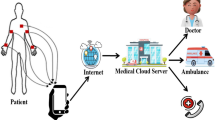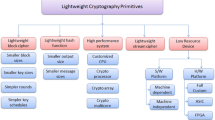Abstract
Machine type communication (MTC) is one of the significant communication paradigms in the fifth generation networks. The existing cellular networks are not designed for massive access of the MTC devices. Therefore, data aggregation and relaying are advocated to reduce the massive MTC access besides other physical layer solutions. In this paper, we propose a secured multiple mobile relay selection algorithm that smartly aggregates data from adjacent MTC devices through multiple user equipments and transmits it to the base station (BS). The paper also presents a framework for the selection of trusted relays to cooperatively aggregate MTC data and render two-hop connectivity to the BS. Our proposed algorithm is compared with existing algorithms on the basis of energy efficiency, system capacity, communication delay and outage probability. Our proposed algorithm outperforms the other schemes by improving outage probability and communication delay by 33% and 25%, respectively.
Similar content being viewed by others
References
Hossain E, Hasan M. 5G cellular: key enabling technologies and research challenges. IEEE Instrum Meas Mag, 2015, 18: 11–21
Guo J, Durrani S, Zhou X Y, et al. Massive machine type communication with data aggregation and resource scheduling. IEEE Trans Commun, 2017, in press
Ali A, Shah G A, Farooq M O, et al. Technologies and challenges in developing machine to machine applications: a survey. J Netw Comput Appl, 2017, 83: 124–139
Chen S Y, Ma R F, Chen H H, et al. Machine-to-machine communications in ultra-dense networks—a survey. IEEE Commun Surv Tutor, 2017, 19: 1478–1503
Ghavimi F, Chen H H. M2M communications in 3GPP LTE/LTE-A networks: architectures, service requirements, challenges, and applications. IEEE Commun Surv Tutor, 2015, 17: 525–549
Ericsson. More than 50 billion connected devices. Technical Report, 2011
Lien S Y, Chen K C, Lin Y. Toward ubiquitous massive accesses in 3GPP machine-to-machine communications. IEEE Commun Mag, 2011, 49: 66–74
Dawy Z, Saad W, Ghosh A, et al. Toward massive machine type cellular communications. IEEE Wirel Commun, 2017, 24: 120–128
Ge X H, Chen J Q, Wang C X, et al. 5G green cellular networks considering power allocation schemes. Sci China Inf Sci, 2016, 59: 022308
Rigazzi G, Pratas N K, Popovski P, et al. Aggregation and trunking of M2M traffic via D2D connections. In: Pro- ceedings of IEEE International Conference on Communications, London, 2015. 2973–2978
Asadi A, Wang Q, Mancuso V. A survey on device-to-device communication in cellular networks. IEEE Commun Surv Tutor, 2014, 16: 1801–1819
Belleschi M, Fodor G, Abrardo A. Performance analysis of a distributed resource allocation scheme for D2D communications. In: Proceedings of IEEE GLOBECOM Workshops (GC Wkshps), Houston, 2011. 358–362
Zhang G P, Yang K, Liu P, et al. Using full duplex relaying in device-to-device (D2D) based wireless multicast services: a two-user case. Sci China Inf Sci, 2015, 58: 082301
Zhang G P, Liu P, Yang K, et al. Orthogonal resource sharing scheme for device-to-device communication overlaying cellular networks: a cooperative relay based approach. Sci China Inf Sci, 2015, 58: 102301
Atat R, Liu L, Mastronarde N, et al. Energy harvesting-based D2D-assisted machine-type communications. IEEE Trans Commun, 2017, 65: 1289–1302
Nosratinia A, Hunter T E, Hedayat A. Cooperative communication in wireless networks. IEEE Commun Mag, 2004, 42: 74–80
van-der Meulen E C. Three-terminal communication channels. Adv Appl Prob, 1971, 3: 120–154
Ur Rehman W, Salam T, Xu J, et al. Capacity enhancement in 60 GHz based D2D networks by relay selection and scheduling. Int J Antenn Propag, 2015, 2015: 205163
Song C, Lee K J, Lee I. Designs of MIMO amplify-and-forward wireless relaying networks: practical challenges and solutions based on MSE decomposition. IEEE Access, 2017, 5: 9223–9234
Ur Rehman W, Salam T, Tao X F. Relay selection schemes in millimeter-waveWPANs. In: Proceedings of International Symposium on Wireless Personal Multimedia Communications (WPMC), Sydney, 2014. 192–197
Xing C W, Ma S D, Zhou Y Q. Matrix-monotonic optimization for MIMO systems. IEEE Trans Signal Process, 2015, 63: 334–348
Ur Rehman W, Salam T, Tao X F. Vertex multi-coloring scheduling algorithm for concurrent transmission in 60-GHz networks. In: Proceedings of IEEE Global Communications Conference (GLOBECOM), Austin, 2014. 4751–4757
Genc V, Murphy S, Yu Y, et al. IEEE 802.16J relay-based wireless access networks: an overview. IEEEWirel Commun, 2008, 15: 56–63
Xing C W, Ma Y, Zhou Y Q, et al. Transceiver optimization for multi-hop communications with per-antenna power constraints. IEEE Trans Signal Process, 2016, 64: 1519–1534
Mohammed A H, Dai B, Huang B X, et al. A survey and tutorial of wireless relay network protocols based on network coding. J Netw Comput Appl, 2013, 36: 593–610
Saghezchi F B, Radwan A, Rodriguez J. Energy-aware relay selection in cooperative wireless networks: an assignment game approach. Ad Hoc Netw, 2017, 56: 96–108
Xing C W, Gao F F, Zhou Y Q. A framework for transceiver designs for multi-hop communications with covariance shaping constraints. IEEE Trans Signal Process, 2015, 63: 3930–3945
Satish Kumar D, Nagarajan N. Relay technologies and technical issues in IEEE 802.16j Mobile Multi-hop Relay (MMR) networks. J Netw Comput Appl, 2013, 36: 91–102
Wang Y, Tao X F, Zhang X F, et al. Cooperative caching placement in cache-enabled D2D underlaid cellular network. IEEE Commun Lett, 2017, 21: 1151–1154
Rebecchi F, de Amorim M D, Conan V, et al. Data offloading techniques in cellular networks: a survey. IEEE Commun Surv Tutor, 2015, 17: 580–603
Nishiyama H, Ito M, Kato N. Relay-by-smartphone: realizing multihop device-to-device communications. IEEE Commun Mag, 2014, 2–11
Andreev S, Pyattaev A, Johnsson K, et al. Cellular traffic offloading onto network-assisted device-to-device connections. IEEE Commun Mag, 2014, 52: 20–31
Zhang S, Wu J, Qian Z Z, et al. MobiCache: cellular traffic offloading leveraging cooperative caching in mobile social networks. Comput Netw, 2015, 83: 184–198
Meng Y, Jiang C X, Chen H H, et al. Cooperative device-to-device communications: social networking perspectives. IEEE Netw, 2017, 31: 12–18
Alim M A, Pan T, Thai M T, et al. Leveraging social communities for optimizing cellular device-to-device communi- cations. IEEE Trans Wirel Commun, 2017, 16: 551–564
Ma Z, Zhang Z Q, Ding Z G, et al. Key techniques for 5G wireless communications: network architecture physical layer and MAC layer perspectives. Sci China Inf Sci, 2015, 58: 041301
Pratas N K, Popovski P. Underlay of low-rate machine-type D2D links on downlink cellular links. In: Proceedings of IEEE International Conference on Communications Workshops (ICC), Sydney, 2014. 423–428
Steri G, Baldini G, Fovino I N, et al. A novel multi-hop secure LTE-D2D communication protocol for IoT scenarios. In: Proceedings of 23rd International Conference on Telecommunications (ICT), Thessaloniki, 2016. 1–6
Pereira C, Aguiar A. Towards efficient mobile M2M communications: survey and open challenges. Sensors, 2014, 14: 19582–19608
Wu G, Talwar S, Johnsson K, et al. M2M: from mobile to embedded Internet. IEEE Commun Mag, 2011, 49: 36–43
Ometov A, Orsino A, Militano L, et al. Toward trusted, social-aware D2D connectivity: bridging across the technology and sociality realms. IEEE Wirel Commun, 2016, 23: 103–111
Nitti M, Girau R, Atzori L. Trustworthiness management in the Social Internet of Things. IEEE Trans Knowl Data Eng, 2014, 26: 1253–1266
Zhao Z W, Szyszkowicz S, Beitelmal T, et al. Spatial clustering in slotted ALOHA two-hop random access for machine type communication. In: Proceedings of IEEE Global Communications Conference (GLOBECOM), Washington DC, 2016. 1–6
Ho C Y, Huang C Y. Energy-saving massive access control and resource allocation schemes for M2M communications in OFDMA cellular networks. IEEE Wirel Commun Lett, 2012, 1: 209–212
Acknowledgements
This work was supported by National Natural Science Foundation of China (Grant Nos. 61325006, 61461136002) and 111 Project of China (Grant No. B16006).
Author information
Authors and Affiliations
Corresponding author
Rights and permissions
About this article
Cite this article
Salam, T., Rehman, W.u., Tao, X. et al. A trust framework based smart aggregation for machine type communication. Sci. China Inf. Sci. 60, 100306 (2017). https://doi.org/10.1007/s11432-017-9186-6
Received:
Accepted:
Published:
DOI: https://doi.org/10.1007/s11432-017-9186-6




